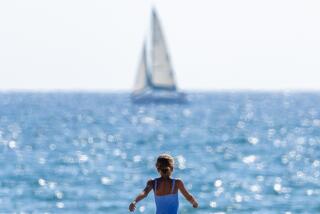Stay cool in the summer heat
- Share via
Used to be travelers could head to Europe to find some relief from the summer heat, but not this year. Since the heat wave hit Britain and the Continent last month, temperatures have hovered near 100 and sometimes above in Britain, Spain, France, Italy and elsewhere. Hundreds of deaths have been blamed on the heat, and some experts predict no real relief until September.
Whether you’re roasting in Paris or Perris, you need to prepare for the heat and learn the warning signs of heat-related illnesses.
To stay as cool as possible, wear light, reflective clothes that are loose fitting. Certain wicking fabrics (such as CoolMax and Dri-Fit) draw perspiration away from your skin to the surface of the fabric, where it evaporates, which can also help. Breathable cotton is preferable to nylon, which can trap perspiration.
Pack handkerchiefs that you can wet and place under your hat, suggests Dr. Randy Wexler, an assistant professor of clinical family medicine at Ohio State University in Columbus. Or try neck coolers such as Kafka’s Kool Tie, $9.50 from www.rei.com, or Kewl Tie, about $6 from www.craftywench.com. The ties are filled with polymer crystals. When soaked in water, the crystals expand and, when the tie is worn, the water is slowly released.
You also might consider hydration backpacks (reservoirs with an attached long straw). Several kinds of hydration packs -- larger models cost about $60 -- are sold online (www.camelbak.com, www.altrec.com) and in sporting goods stores.
It’s also crucial to know the warning signs of heat-related illness, when you can treat it yourself and when you need immediate medical care.
Among the most serious problems are heat exhaustion and heatstroke. Heatstroke can be life threatening, says Dr. Glen Grayman, an emergency medicine physician and medical director of the Richards Emergency/Trauma Center at Desert Regional Medical Center in Palm Springs.
Heat exhaustion, which can be mild or severe, is common and often not reported, so statistics are harder to come by. On average, 182 people die each year in the U.S. of excess heat resulting from weather, according to the Centers for Disease Control and Prevention.
Infants and the elderly often find it more difficult to cope with the heat, because babies have underdeveloped thermoregulatory systems and the elderly often have systems that falter when dealing with thermal stress.
Heat exhaustion is defined as excessive fluid loss due to sweating, resulting in fatigue, weakness and anxiety. When heat exhaustion strikes, people often feel lightheaded and nauseated, almost as though they are getting the flu, Grayman says.
The skin is usually cool and clammy, breathing is fast and shallow, and the pulse is rapid and weak.
“Pretty much everyone has experienced heat exhaustion,” Grayman says. “When you are outside in the heat, doing yard work, and you feel woozy, that’s heat exhaustion.” The remedy is simple: “Get yourself out of the heat and replace fluids,” Grayman says.
Sports drinks, such as Gator- ade, are probably better than water, he says, because they also contain minerals. And kids are more likely to drink sports drinks than water because they prefer the taste.
A person suffering heat exhaustion needs to remove as much clothing as possible. Another way to cool down: “Put ice packs under the arms and in the groin area,” says Wexler. “Those are areas of high heat production.”
If heat exhaustion symptoms don’t improve after an hour or two, you may need medical care. Some patients need intravenous fluids.
The last step in treating heat exhaustion is to take it easy. “You really need to back off for 48 hours or so if you have had heat exhaustion symptoms,” Wexler says. Avoid going out into high temperatures, and give your body time to recover.
If symptoms become more serious, suspect heatstroke and get medical attention immediately.
“It used to be thought that heat exhaustion and heatstroke were different,” Grayman says. “Now it is thought that it is probably on a continuum.”
Wexler says, “Heat exhaustion should be thought of as a precursor to heatstroke.”
Heatstroke occurs when the body temperature rises above 103 degrees and the body is unable to cool itself down. “Heatstroke is life threatening,” Grayman says. “The body’s ability to shed heat is overwhelmed by the external temperature.”
The brain is sensitive to high temperatures, Grayman says, so confusion, lethargy, stupor, seizures and even coma can follow. Other organs, including the liver and kidneys, can start to malfunction, he says.
The skin becomes red, hot and dry, and the pulse is rapid and strong. Headache, dizziness and nausea can occur.
Medical attention is crucial. Doctors will replace fluids and vigorously cool down the patient.
Certain medications can predispose you to heat-related ailments, Grayman and Wexler say, including antihistamines. “Antihistamines impair the body’s ability to sweat,” Wexler says. “Continue to take your antihistamines, but pay attention to the heat.”
Anti-seizure medications boost the risk of heat-related problems, experts agree, as does drinking alcoholic beverages during heat exposure. Drinking coffee will dehydrate you further, Grayman says.
While in the heat, pay attention to fluid intake. Drink a pint of water before you go out into the heat, and then another half-pint every 20 minutes.
“The idea is that thirst lags behind your body’s needs,” Grayman says. “You need to stay ahead of the fluid loss.”
Healthy Traveler appears twice a month. Kathleen Doheny can be reached at [email protected].
More to Read
Sign up for The Wild
We’ll help you find the best places to hike, bike and run, as well as the perfect silent spots for meditation and yoga.
You may occasionally receive promotional content from the Los Angeles Times.






